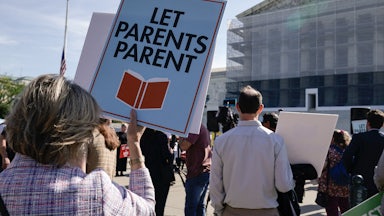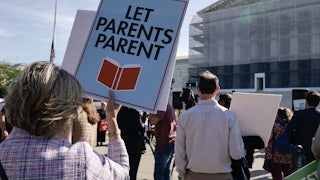Democrats have heard a lot, in recent weeks, about what they don’t want to hear. Earlier this month, The New York Times’ Ezra Klein ran a piece about the data analyst David Shor, the principal advocate of what’s being called popularism. Shor’s been everywhere over the past year—including in the pages of The New Republic. And Politico reported recently that he’s found a ready “audience with the White House.” “Some aides in the White House pay close attention to Shor’s analysis and have talked with him about his data, according to two sources familiar with the matter,” Playbook’s authors wrote. “He’s advised Democrats to stand against ‘defund the police,’ not talk too much about immigration, assume that Twitter is not real life, and talk about things that already have approval instead of trying to make unpopular things popular.”
Unsurprisingly, popularism has itself gotten fairly popular among center-left pundits and has earned the ire of progressive journalists and activists. The debates between the two camps have been heated, but there’s a good chance we might remember them fondly before long—these were the debates we could have with one another, we might say to ourselves in a decade, when it was still possible to believe the Democratic Party had a future to win. It’s not at all obvious that the party does; popularism, in its pat simplicity and similarity to age-old Democratic nostrums, will not build it one.
In full, Shor’s argument goes something like this: Democrats are in deep trouble. While the party managed to take full control of government in 2020, Republicans are poised to return to power in Washington soon—beyond the losses that incumbent parties tend to suffer in midterm elections, Democrats are further endangered by the Electoral College’s current skew and the Senate’s worsening malapportionment. In his interview with Klein, Shor gave the Senate math special attention: According to his model, Senate Democrats will have to win the midterm vote by more than four percentage points to have a better than even chance of keeping the chamber, and a bare 51 percent majority of the two-party vote in 2024 would result in a loss of seven seats.
There’s no real long-term fix for this situation beyond structural reforms, such as the addition of new states, a project Democrats aren’t yet serious about. But Shor and his fellow popularists are also recommending another complementary remedy: Democrats should take issue polls more seriously and fully commit themselves to doing and saying popular things. If Democratic candidates avoid fanning the flames of the culture wars and support modest reforms on sensitive issues like policing and immigration, the party will have an easier time making up ground among the white working-class voters and wavering moderate-to-conservative voters of color who moved right under Trump.
Additionally, the theory goes, the Democrats would do well to avoid running on or attempting sweeping policy changes when moderate alternatives are more readily available, more plausible, and more popular—means-testing their expansion of the Child Tax Credit, for instance, or passing prescription drug pricing reform rather than attempting another major and massive health care reform bill. The public, after all, can be fickle when it comes to big policy swings: Research suggests public opinion is “thermostatic,” with voters supporting spending and bigger government when government is small, cuts and smaller government after government gets bigger.
Candidates seeking a model of Shor’s approach to draw from need look no further than the last Democratic president. Barack Obama, the popularists hold, succeeded in positioning himself in the cultural middle, where he managed to appeal broadly to many of the white working-class voters, especially in the upper Midwest, whom Democrats need to win back. And Obama’s 2012 campaign, which Shor worked on, set an example Democratic campaigns should still be following. “His campaign, knowing that pandering to low-income rural white people is not what comes most naturally to liberal professionals, imposed ruthless message discipline on the whole party,” Matt Yglesias wrote earlier this year. “They decided what every surrogate who went on television was supposed to say, and they’d get really fucking pissed at you if you went off-script and talked about what you thought was important rather than what they thought would help them persuade swing voters in pivotal states.”
The debates over these arguments have generally followed a few fairly specific and granular lines of inquiry—empirical claims about what electoral data actually tells us, alternative theories of turnout and persuasion, and so on. But here, we ought to take a moment to consider how solidly conceived and persuasive popularism is on a basic conceptual level. Before we get to the question of whether Democrats should say and do popular things, how should we go about deciding which ideas are popular in the first place? It’s been well established that the results of issue polls can be skewed by the wording of questions; even when good numbers are at hand, interpreting them properly is another matter entirely. Is there a particular margin ahead of or relative to an alternative that should suggest a policy is popular? Is there an absolute level of support that should? What is it? A large plurality? Majority support? Sixty percent? Seventy percent? Should health care policies be evaluated at a different threshold than criminal justice or climate policies? Why, or why not?
Things don’t get much simpler even if one assumes assessing popularity is straightforward. Should politicians really just say and do what most of the public wants them to say and do? If, for whatever reason, we found ourselves in a position where the majority of Americans came to support something morally grotesque—another catastrophic war in the Middle East, rounding up Muslims, or some other grand atrocity—we might generously presume that most liberal popularists would oppose the Democratic Party following suit. So with a reasonable caveat, “Say and do popular things” becomes something more like: “Say and do popular things unless those things are too substantively terrible to support.”
How total is popularism’s rejection of the unpopular? Shor, for instance, has been an advocate of granting statehood to not only the District of Columbia and Puerto Rico but the other American territories, including the U.S. Virgin Islands and American Samoa. While the polling for D.C. statehood has improved and Shor says there’s a solid amount of support for admitting the other territories, the addition of states would nevertheless be significantly more divisive relative to other democratic reforms that Democrats have chosen to talk up and pursue, such as campaign finance reform and election security measures, both of which register support north of 80 percent.
Moreover, the simultaneous addition of a slew of new majority-minority states would likely become more unpopular at the moment of implementation than the polls now suggest—a sweeping and radically disruptive change to the status quo pushed by the self-styled advocates of Democratic caution. Nevertheless, Shor rightly believes that adding states is the right thing to do, both substantively and as a matter of long-term political strategy, given the needed boost it would give Democrats in the Senate and the Electoral College. Here, we can amend the initial slogan again: “Do and say popular things with the understanding that some popular things might be too terrible to support and that some divisive or unpopular things might be worthwhile.”
But having introduced the concept that public opinion can change, we can complicate things further. In March 2009, just weeks before its passage, CNN’s polling showed Americans supporting the American Recovery and Reinvestment Act by a 10-point margin, 54–44 percent. By January 2010, the numbers had flipped, with 56 percent of Americans opposing the stimulus and 42 percent supporting it. Conversely, as many have noted over the past few weeks, a popularist might have told Obama to forget about another bailout of the auto industry in 2009—according to Gallup, a 72 percent majority of American voters opposed the idea, which only registered about 28 percent support even in the Midwest. But by the time Obama’s reelection campaign rolled around, the numbers had changed significantly. In February 2012, Pew found that 56 percent of Americans believed the bailout had been “mostly good” for the economy—a full reversal from October 2009, when 54 percent of Americans considered it “mostly bad.”
Taking this into account, we can now move from “Democrats should say and do popular things” to “Democrats should say and do popular things with the reasonable and obvious caveats that some popular things might be too terrible to support, that some divisive or unpopular things might be worthwhile, that some popular things might become unpopular, and that some unpopular things might become popular.” Simplified further, you get something like “Democrats should make case-by-case decisions on what policies to pursue and advocate for, based not only upon public opinion but the substantive value and strategic benefits of the policies in question, both now and over time.”
Actually, this can be put even more succinctly. Popularism, Shorism, or whatever you’d like to call it, is simply the theory that Democrats should engage in politics. And it’s hard to disagree with this, really. But the notion that Democrats should be making strategic choices isn’t, in itself, a real guide to the choices that ought to be made—the numbers alone cannot tell us what risks are worth taking, what sacrifices are worth making, and what policies are substantively worthwhile.
This is the hole at the center of popularism; many of its critics suspect that popularists want us to fill it simply by adopting their own policy priorities and cultural preferences. Whatever their motivations, it does seem important to recognize how our normative priors can shape the way polls are read. Shor, who does not believe climate change is as grave a problem as Chinese power, might come to different conclusions about what Democrats should do on the issue than another analyst looking at the same numbers who, like climate scientists and most of the international community, believes climate change is perhaps the gravest problem humanity has ever faced.
But a biased interpretation of the polls isn’t necessarily a strategically incorrect one; the popularists argue that whatever we think about them and their politics, it is simply true that the Democratic Party needs to spend less time satisfying the whims of college-educated progressives and more time accommodating the voters who actually matter, given the structure of our federal system—the moderates and conservatives the party’s lost to the right. “If you look inside the Democratic Party, there are three times more moderate or conservative nonwhite people than very liberal white people, but very liberal white people are infinitely more represented,” Shor told Klein in his interview. “That’s morally bad, but it also means eventually they’ll leave.”
In his piece on Obama’s 2012 campaign, Yglesias summarized the party’s strategic devolution since. “What’s changed is that Democrats went from being an urban-based diverse party that nonetheless tried pretty hard to pander to the views of rural white people in hopes of getting the votes of the poorer and less-religious among them, to becoming a party that decided it would be unnecessary or immoral to pander like that,” he wrote. “But the Senate map (and to a lesser extent the Electoral College) makes it absolutely necessary to pander to the views of rural white people.”
What would it look like if Democrats did? What policies and rhetoric would the party push if it took the need to win and keep moderate and conservative voters—white and nonwhite, rural and urban, barely inside and just outside the Democratic coalition—as seriously as the popularists say it should? Well, for starters, it’s certain that the leaders of a popularist Democratic Party would repudiate defunding the police. In fact, one might imagine a popularist Democratic president increasing federal funding for police departments while supporting reforms like an end to qualified immunity for law enforcement. A popularist administration might make a feint at attempting the doomed immigration legislation most voters support, but the White House, wary of alienating moderate and conservative whites, would probably drag its feet a good bit on reversing the previous administration’s restrictions by executive action and avoid raising immigration as an issue unprompted.
Democratic leaders would probably pay lip service to the major democratic reforms college-educated liberals in advocacy groups and on the internet want—the addition of new states, restructuring the Supreme Court—before ultimately opting for a basic compromise on voting rights, one that might even include voter ID provisions. They’d make the same move on health care—trying out, as previously mentioned, wildly popular but incremental proposals such as prescription drug pricing reform and expanding Medicare to cover dental, vision, and hearing over another more comprehensive reform effort. Surely, they’d be happy to let gun control fade from national conversation. And a popularist Democratic president would obviously defend American idealism from both progressive pessimists and the right’s budding authoritarians alike. “America is an idea,” they might say. “The most unique idea in history: We are created, all of us, equal.”
A popularist Democratic Party might, in short, bear an uncanny resemblance to the Democratic Party we already have, right now, under Joe Biden. And if reviving the party’s fortunes were simply a matter of tacking to the middle, Biden would probably be doing better in the polls than he currently is—since February, his approval rating has fallen across all demographic groups and substantially among Hispanics and independents, whose support has declined by about 20 and 15 points, respectively, since January. That’s not to say that Biden’s losing ground because of his moderation—it’s normal for presidents to take a hit in their first year—or that he’d be doing better if he’d veered left on the issues popularists highlight. But Biden’s standing does seem to tell us that the forces shaping public opinion and the Democratic Party’s future are more complex than the popularists tend to imply they are.
As many have noted in recent weeks and as Shor has acknowledged himself, popularism is largely a retread of very old Democratic ideas. “When I first started working on the Obama campaign in 2012, I hated all the last remnants of the Clinton era,” he told Klein. “When I go back now and think about the fights between the analytics team and the consultants, about 80 percent of the time, they were right. There was an old conventional wisdom to politics in the ’90s and 2000s that we all forget.” But the Democratic conventional wisdom of the 1990s and 2000s is really still the Democratic conventional wisdom of today: Again, the party’s already hewing to the middle on contentious issues, and punditry across all mediums is dominated by voices shaped by Clinton- and Bush-era politics.
On one level, it’s not hard to understand why James Carville gets dusted off and wound up every few months to warn Democrats about the left—for quite some time, what we now call the popularist approach really did look like the key to the Democratic Party’s viability in the constituencies and regions with which it now struggles. Exit polls suggest Clinton might have actually won the white working class in 1992 and 1996; Obama came to the White House in 2009 with a Senate majority that contained two Democratic senators from Arkansas.
But below the surface, the party’s electoral foundations were rotting away. According to data reviewed by The New York Times’ Nate Cohn, two major erosions in Democratic support from non-college whites in presidential elections occurred under Clinton and under Obama—the very periods when the popularists insist Democrats were doing what it took to keep white working-class voters in the fold. And ironically, angst about Democrats alienating the white working class is picking up again at a moment when Democrats actually seem to be making up some ground—2020 saw the first increase in Democratic support among white non-college voters in a presidential election since the mid-2000s.
The pandemic and the economy probably deserve a good deal of credit for that bump; Democrats are still well below where they need to be if they’d like to securely control government again. But it’s not at all obvious that the last two Democratic administrations offer a blueprint for how the party might retain non-college whites in order to do so. If Biden loses the House or Congress entirely next year, it will be a defeat presaged by Obama’s first-term shellacking in the House in 2010 and Clinton’s loss of Congress in 1994.
The soon-to-be-conventional wisdom that Obama was a white working-class whisperer who succeeded in appearing moderate to the electorate is particularly bizarre. In December 2011, a Gallup poll asked Americans to place themselves and 2012 presidential candidates on an ideological scale from 1 to 5, with 1 being very liberal and 5 being very conservative. On average, respondents rated themselves at 3.3 points and Obama at 2.3 points. That one-point gap might not seem like a particularly large difference, but it was the largest gap between a candidate’s perceived ideology and the average self-rating of any of the candidates tested. Michelle Bachmann, the infamous Tea Party crank, was rated only 0.7 points away from where Americans saw themselves ideologically; Mitt Romney, the eventual Republican nominee, was only 0.2 points away. In a similar postelection survey released by the Public Religion Research Institute in November 2012, voters again placed Obama a full point away from themselves and Romney 0.5 points away.
It may well be true, as Yglesias has written, that Biden “sounds more left on racial issues” than Obama did, wary as Obama was of deepening the salience of his race. But Biden still seems much more moderate to voters than Obama was. An NBC poll taken around the end of Obama’s first 100 days in office, in April 2009, found that 59 percent of Americans saw Obama as “very” or “somewhat” liberal. This past April, only 44 percent said the same of Biden.
Getting an accurate picture of Obama’s standing before and during the 2012 election is particularly important here, given that popularists tend to argue that Democrats lost their way with white working-class voters largely by boosting the salience of issues like gun control, immigration, and policing during his second term. But we shouldn’t let the drubbing Democrats took at the end of Obama’s presidency obscure how polarizing he was as a figure from the very beginning of it. Despite his patriotic rhetoric and efforts to ride the median on issues like immigration and gay marriage, Obama was perceived as culturally alien by a very large portion of the electorate very early on; so little has been made of this obvious fact in the popularist assessments of his presidency that one has to wonder whether we’re starting to forget it.
A post-midterm survey released by PRRI in November 2010 found that a 51 percent majority of Americans and 56 percent of Americans without college degrees believed Obama held different religious beliefs from their own; a few months before, Pew had found that a 43 percent plurality of Americans, including 41 percent of Democrats, said that they did not know what religion Obama belonged to. Nearly a fifth of Americans, in that same poll, believed—or claimed to believe—that Obama was a Muslim. And of course, in a then-shocking finding, both The New York Times and CNN found, in the spring of 2011, that roughly a quarter of Americans believed Obama had been born outside the United States.
Obama was seen as so toxic to white working-class voters at the time, in fact, that some Democratic candidates in battleground regions urged him to steer clear of them. “Instead,” Politico reported in October 2010, “the president has been forced to stick, for the most part, to college campuses and big cities, like Seattle, Philadelphia, Cleveland, Madison and Portland [Oregon].” Elsewhere in that piece, Claire McCaskill levels the same criticisms against Obama as the defenders of his record with the working class are now leveling against the Democratic Party as a whole. “He can roll up his sleeves and he can take off his jacket and he could not wear a tie, but it is very hard for a lot of people in working-class families to imagine him next to them at the laundromat,” she told Politico. “His vocabulary is beyond impressive, [but] the fact that he stays visionary sometimes slows him down.”
Her sentiments were echoed by a now familiar face:
West Virginia Gov. Joe Manchin is taking a political battering, thanks to his support of Barack Obama, so he’s uniquely qualified to offer counsel on what many think is the president’s central political problem—his failure to connect with white working-class voters.
His advice: Go to where they live and work. Listen. And don’t talk down to them.
“If I were him, I’d start going to the places where people don’t like you that much,” said Manchin, who is locked in a close race to replace Robert Byrd in the Senate and struggling mightily to shrug off his opponents’ description of him as Obama’s “rubber stamp.”
“You can’t win if you only go where you are comfortable,” added Manchin, who was speaking to POLITICO a day before Obama appeared in a place that was very much in his comfort zone, before a crowd of 35,000 admirers at Ohio State University.
While Obama really had made gains with the white working class in 2008, those gains happened to coincide with an economic crisis that came at the end of an already deeply unpopular Republican president’s second term. Despite his populist rhetoric, Obama lost ground with them in his reelection campaign, and the Democratic Party as a whole took a severe beating over the course of his presidency, losing 11 Senate seats, 62 House seats, 12 governorships, and well over 900 state legislative seats.
The Obama years only look like a relative success for the party from a post-2016 vantage point: Educational polarization deepened even more significantly once Trump entered the picture, and 2012 became a natural statistical benchmark. If Hillary Clinton had maintained the same ratio of college-to-non-college-educated voters as Obama’s campaign had, Shor has said, for instance, she would have won. Even so, it doesn’t at all follow that simply emulating Obama will actually reproduce the party’s 2012 margins now: If anything, Biden is, again, already having more success positioning himself as a moderate than Obama was at this point in his presidency with seemingly little effect on his standing in the polls. The problem for Biden and the party as a whole is that the electorate has fundamentally changed. And it will take much more than savvy messaging to change it back. “The last ten years have had a huge effect on the partisan allegiance of millions of white working-class voters who used to vote for Democrats,” Nate Cohn wrote earlier this month. “The old bonds of party loyalty are gone. They don’t default to Democrats anymore. Many are now just Republicans.”
White racial anxiety is often given pride of place in explanations of how that shift happened. But while race is undoubtedly central, it should be understood that the Democratic Party’s cultural problems are even larger than those diagnoses suggest—the pandemic and the furor over masks and mandates have demonstrated how easily a polarized and nationalized media environment can spin new material for the culture wars out of virtually nothing. A few decades ago, voters could turn to local media for news on the impact decisions made by their representatives in Washington were having on local affairs; ticket-splitting flourished in an era when bringing home the goods mattered much more than the letter at the end of a candidate’s name and whatever national narratives were being advanced about the two parties. But that’s an era long gone—as Ezra Klein noted in his piece on Shor, about half of the senators who served between 1960 and 1990 were of a different party than their state’s choice for president, while only six are today.
Material conditions shouldn’t be given short shrift in analyses of the Democratic Party’s woes, either. According to a recent report by Democratic strategist Richard Martin, about half of the Republican Party’s gains in the 10 upper Midwest and Rust Belt states between 2012 and 2020 were made in counties that had lost manufacturing jobs and experienced declines in health outcomes. And in several states, the researchers added, declines in union membership in the year 2010 alone exceeded the margin of Clinton’s losses in 2016.
In his interview with Klein, Shor blamed those losses mostly on the race’s focus on immigration to the exclusion of economic issues. Clinton, he argues, “lost because she raised the salience of immigration,” he said, “when lots of voters in the Midwest disagreed with us on immigration.” It should be clear to all by now that Hillary Clinton ran a poor campaign in 2016 and deserves much of the blame for all that’s happened since. But the candidate who raised the salience of immigration in 2016 was, obviously, one Donald J. Trump. “Immigration” was one of the top words associated with his candidacy, according to Gallup’s polling from July to September that year. Clinton’s top word, by a substantial margin, was “email.”
In his content analysis of Clinton’s campaign speeches, Vox’s David Roberts found that Clinton mentioned immigration a fraction of the number of times she mentioned “jobs,” “the economy,” and “workers.” The actual content of that economic messaging might have been subpar, and Clinton could have done more in the final stretch to push a better message in the states that would ultimately determine the result. But immigration was locked in as a salient issue the moment Trump entered the race. Clinton’s problem wasn’t that she raised the salience of immigration but that her candidacy and platform weren’t strong enough to overcome it as an issue in key constituencies. This is how American politics tends to work. There are two players in this game—an incendiary Republican Party that fans cultural fires with the assistance of the press; and a weak, reactive, and habitually cautious Democratic Party that always finds itself huffing and puffing to put them out.
The trouble for the popularists is that liberals—who made up nearly half of the Democratic primary electorate last year, a larger share than ever before—have shifted dramatically to the left on cultural issues in recent years. Democratic candidates and organizations depend on liberal time, liberal money, and liberal votes; it makes no more sense to suggest that the priorities of cultural progressives could simply be kicked to the curb than it does to suggest that the Republican Party could easily free itself from the grip of pro-life and gun rights groups. And even if it were true that it’s structurally more important for Democrats to rein in their outré voices than it is for Republicans, that need wouldn’t make the task any easier to accomplish. Bill Clinton’s “Sister Souljah moment” and the political impact of the crime and welfare reform bills have been immortalized in political memory; fewer remember that racial politics within the Democratic coalition remained polarizing enough under Clinton, despite his best efforts, that the chair of the Congressional Black Caucus and major civil rights leaders courted by Democratic candidates were willing to play footsie with Louis Farrakhan.
But while message discipline is never really total, and advocacy groups can’t easily be muzzled, it should be acknowledged, again, that the Democrats under Biden are already doing as much of what the popularists are asking of them as could reasonably be expected. In fact, they were doing popularism before it had a name—the message that Democrats supposedly “don’t want to hear” is pretty much the only advice Democratic leaders have been willing to listen to for the last 30 years.
And their total commitment to the safe and the inoffensive endangers the rest of Shor’s project. The chances of major structural reforms being enacted while the Democrats hold Congress are dim not because college-educated progressives in advocacy groups and on Twitter hold too much influence over the party, but because they hold so little on this front that they’ve been ignored by the party’s pivotal actors. And as skilled as they might be at winning white moderates and conservatives, it’s those pivotal actors—Manchin, Sinema, and the other Democrats working, publicly and privately, to hobble even the popularist portions of Biden’s agenda—who are doing the most to pull the party toward oblivion.
What about the left? Do we have a more viable electoral strategy for the near term? Well, not really. A large and durable constituency for left politics still has to be built; doing so will take time and a good deal of nonelectoral organization. And this is the work we should tend to while Democratic leaders and their favorite pundits try to restack their house of cards. It would be unkind, though, if we didn’t leave them to it with at least a little bit of friendly advice: “Do popular things” might sound great to those who say it, but it’s not a very helpful slogan.










